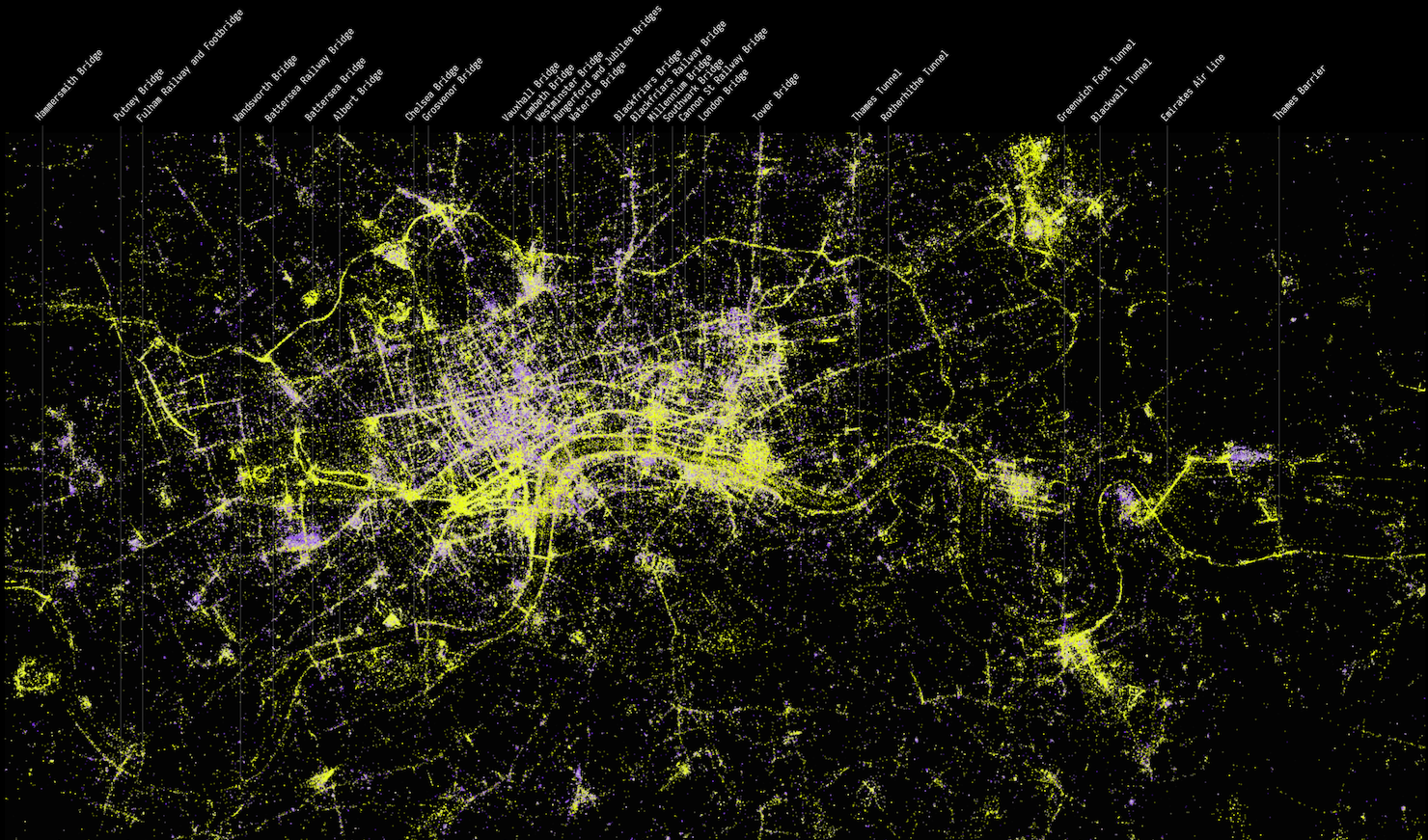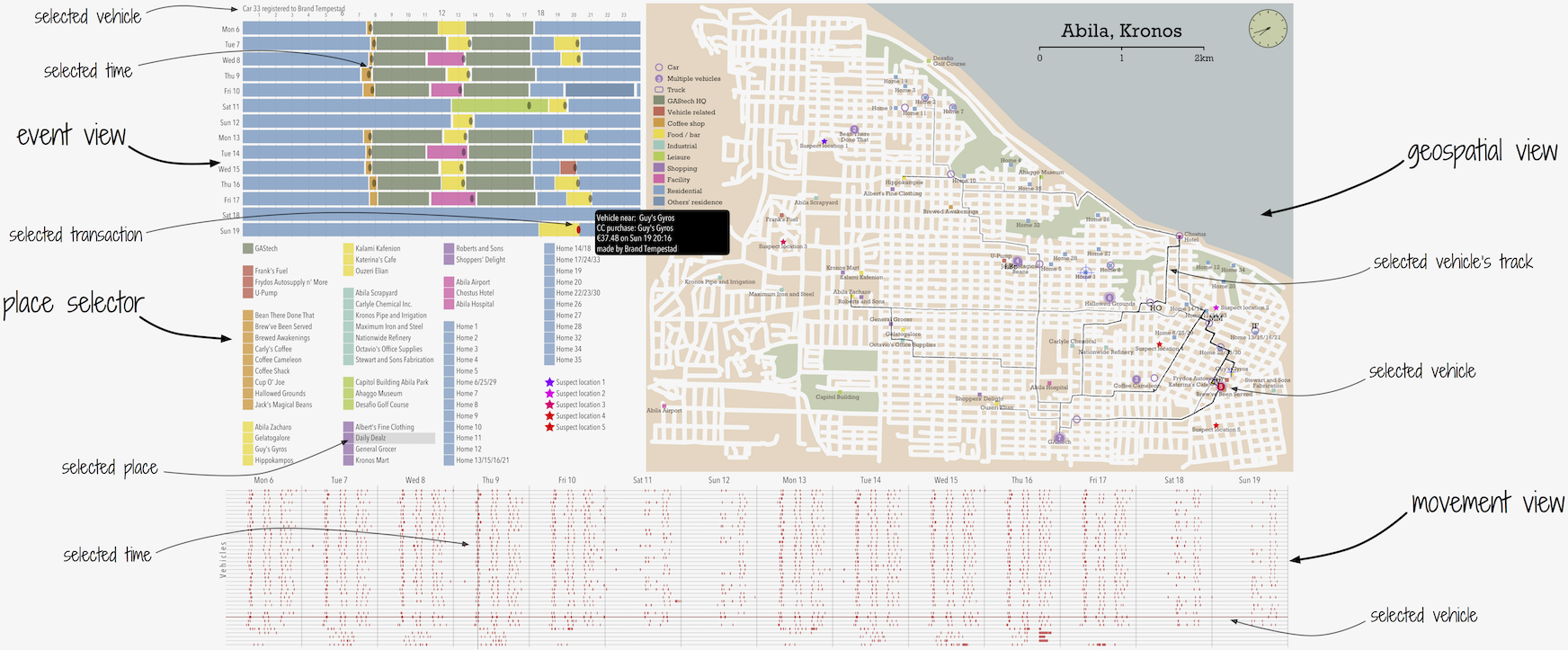
CUSO Spatio-Temporal Data Visualization Workshop, May 2017
Part 1: Introduction to Spatio-temporal visualisation design
Slides for part 1 available here: http://staff.city.ac.uk/~jwo/datavis/cuso2017/IntroSpatioTemporalDesign.pdf
Selected images and links from talk

Interactive bicycle race visualization
Exercise: Symbolising and reordering a table
Using http://www.bertifier.com , select the European Values dataset and experiment with
-
Symbolising the numbers graphically
-
Reordering the rows and columns of the table so that location of your symbols carries useful meaning.
-
What kinds of patterns can you reveal in the data?
Exercise: Deconstructing a spatio-temporal visual analytic design
(These questions can be asked of any visualizaton design, but see if you can answer them for the VAST Challenge 2014 example)

-
What forms of D → V encodings have been used here?
-
Are there any hallucinators? (changes in visualization that don’t reflect changes in data)
-
Are there any confusors? (changes in data that are not reflected in the visualization)
-
How consistent is the visual-data correspondence?
-
How would you go about detecting hallucinators and confusers and correspondence?
-
Where have juxtaposition, superposition and explicit encoding been used? Are they effective?
See also (after completing this exercise!) :
For details of the challenge itself: http://www.vacommunity.org/VAST+Challenge+2014%3A+Mini-Challenge+2
Wood, J. (2014). Visual analytics of GPS tracks: From location to place to behaviour
available at http://www.staff.city.ac.uk/~jwo/datavis/cuso2017/papers/wood_visual_2014.pdf
and video explaing how the vis design answers the challenge: https://vimeo.com/100526597
Part 2: Relaxing Geography
Slides for part 2 available here: http://staff.city.ac.uk/~jwo/datavis/cuso2017/RelaxingGeography.pdf
London Bicycle Hire Visualization
Experiments in bicycle flow animation https://vimeo.com/33712288
"We are the City" https://vimeo.com/jowood/watc
TEDx talk on data visualization design for understanding cyclists' behaviour:
OD Maps and migration
-
Global migration viewer: http://www.staff.city.ac.uk/~jwo/datavis/cuso2017/migration
Exercise: Designing spatio-temporal datavis for movement ecologists
A movement ecologist wishes to understand goose migration across Europe.
She has GPS data for 25 geese showing their hourly movements over a 5 month period.
Geese do three things:
-
They nest, spending time at a single location
-
The forage for food – shorter trips to and from nest
-
The migrate – longer trips from central Netherlands > NE The don’t all show these behvaviours at exactly the same time, but all within an approximate 4 month period.
She tried to implement some Datavis using GoogleEarth (see slides).
(using pencil and paper) can you design a better data visualization to reveal spatio-temporal patterns?
Articles and books mentioned in talk
Bertin, J. (2010) Semiology of Graphics: Diagrams, Networks, Maps. ESRI Press
See http://esripress.esri.com/display/index.cfm?fuseaction=display&websiteID=190 for details.
Gleicher, M., Albers, D., Walker, R., Jusufi, I., Hansen, C. and Roberts, J. (2011) Visual comparison for information visualization. Information Visualization, 10(4) pp.289-309.
Available at http://cvev.bangor.ac.uk/paper.pdf
van Goethem, A., Meulemans, W., Speckmann, B. and Wood, J. (2015) Exploring curved schematization of territorial outlines. IEEE Transactions on Visualization and Computer Graphics, 21(8), 889-902.
Available at http://openaccess.city.ac.uk/8221
van Goethem, A., Reimer, A., Speckmann, B. and Wood, J. (2014). Stenomaps: Shorthand for shapes. IEEE Transactions on Visualization and Computer Graphics, 20(12), pp. 2053-2062.
Available at http://openaccess.city.ac.uk/14151/
Kindlmann, G. and Scheidegger, C. (2014) An algebraic process for visualization design. IEEE transactions on visualization and computer graphics, 20(12) pp.2181-2190.
Available at https://www.researchgate.net/profile/Gordon_Kindlmann/publication/265470662_An_Algebraic_Process_for_Visualization_Design/links/541030e10cf2df04e75b7707.pdf
Meulemans, W., Dykes, J., Slingsby, A., Turkay, C. and Wood, J. (2016). Small multiples with gaps. IEEE Transactions on Visualization and Computer Graphics, 23(1) pp. 381-390.
Available at http://openaccess.city.ac.uk/15167
Munzner, T. (2015) Visualization Analysis and Design, CRC Press
See http://www.cs.ubc.ca/~tmm/vadbook/ for details
Perin, C., Dragicevic, P. Fekete, J-D. (2014) Revisiting Bertin matrices: New interactions for crafting tabular visualizations. IEEE Transactions on Visualization and Computer Graphics, 20(12) pp.2082-2091.
Available at http://www.aviz.fr/wiki/uploads/Bertifier/bertifier-authorversion.pdf
Wood, J. (2015). Visualizing personal progress in participatory sports cycling events. IEEE Computer Graphics and Applications, 35(4), pp. 73-81. Available at http://openaccess.city.ac.uk/12351
Wood, J. (2014). Visual analytics of GPS tracks: From location to place to behaviour. Proceedings, Visual Analytics Science and Technology, VIS 2014
Available at http://www.staff.city.ac.uk/~jwo/datavis/cuso2017/papers/wood_visual_2014.pdf
Wood, J., Badawood, D., Dykes, J. and Slingsby, A. (2011) BallotMaps: Detecting name bias in alphabetically ordered ballot papers. IEEE Transactions on Visualization and Computer Graphics, 17(12), pp.2384-2391.
Available at http://openaccess.city.ac.uk/436
Wood, J., Dykes, J. and Slingsby, A. (2011) Visualizing the dynamics of London’s bicycle hire scheme. Cartographica, 46(4) pp.239-251.
Available at http://openaccess.city.ac.uk/538
Wood, J., Dykes, J. and Slingsby, A. (2010) Visualisation of origins, destinations and flows with OD Maps. The Cartographic Journal, 47(2) pp.117-129.
Available at http://openaccess.city.ac.uk/537